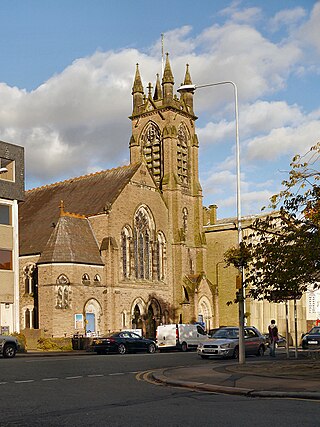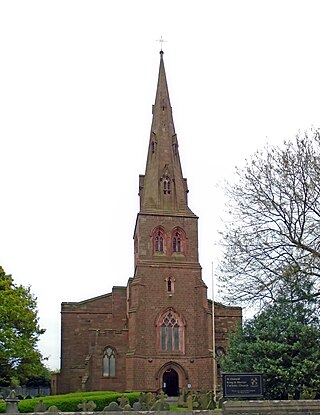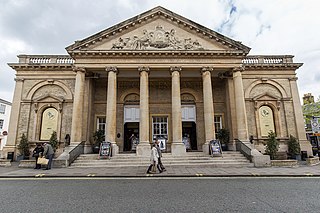
50 Glebe Place is a large terraced house on Glebe Place in the Chelsea SW3 district of London, England. It was built between 1985 and 1987 for the advertiser Frank Lowe. [1] Ed Glinert, in The London Compendium, described it as a folly. [2]

50 Glebe Place is a large terraced house on Glebe Place in the Chelsea SW3 district of London, England. It was built between 1985 and 1987 for the advertiser Frank Lowe. [1] Ed Glinert, in The London Compendium, described it as a folly. [2]
The London: North West edition of the Pevsner Architectural Guides describes the property as featuring a "tall eclectic entrance tower". [3] [4] The building is of three storeys, the topmost being inside the roof space, with a roof garden as well. The tower is of four storeys with windows at each level and a weather vane at the top of a pitched roof. The building is notable for the six statues on its mansard roof, each different, four across the ridge and two others either side of the base of the roof slope, as well as the terracotta figure of a seated girl atop a pillar next to the entrance. The roof is tiled with a multi-coloured pattern of chevrons. There is extensive use of metalwork in front of the windows and for drainage, and a three-part painted inset at the base of the roof.

St Alban's Church in Macclesfield, Cheshire, England, is a Roman Catholic parish church. The church is recorded in the National Heritage List for England as a designated Grade II* listed building. It was designed by A. W. N. Pugin and is described as a "church of exceptional interest among the works of this major architect".

Crypt Chambers is at 28–34 Eastgate Street and 34–40 Eastgate Row, Chester, Cheshire, England. It is recorded in the National Heritage List for England as a designated Grade I listed building and incorporates a section of the Chester Rows.

St Mary's Church is an Anglican church in the village of Slaugham in Mid Sussex, one of seven local government districts in the English county of West Sussex. The 12th- and 13th-century church, restored in the Victorian era, serves a large rural area of the Sussex Weald, covering three villages as well as the ancient settlement of Slaugham. It also controlled the church in the market town of Crawley—now one of the area's largest towns—for the first few centuries of its existence. A locally important family built a private chapel in the church in the 17th century, and a series of memorials to deceased family members are considered to be excellent examples of their type. English Heritage has listed the building at Grade II* for its architectural and historical importance.

St Mungo's Church is in the village of Dearham, Cumbria, England. The church is dedicated to St Mungo, also known as Kentigern, the apostle of Strathclyde. It is an active Anglican parish church in the deanery of Solway, the archdeaconry of West Cumberland, and the diocese of Carlisle. The church is recorded in the National Heritage List for England as a designated Grade I listed building.

St Chad's Church is an Anglican church in Poulton-le-Fylde, Lancashire, England. It is an active parish church in the Diocese of Blackburn and the archdeaconry of Lancaster. It is recorded in the National Heritage List for England as a designated Grade II* listed building. A church on the site was built no later than the 11th century and may have existed prior to the Norman Conquest of England. The tower dates from the 17th century, and much of the remainder of the building from a major renovation in the 18th century, although some of the fabric of the original structure remains. Further renovation and additions took place in the 19th, 20th and 21st centuries.

St Nicholas Church is a historic church in Westgate Street in the city of Gloucester, England, under the care of The Churches Conservation Trust. It is recorded in the National Heritage List for England as a designated Grade I listed building. Its truncated spire is a landmark in the city centre.

St Mary Magdalene's Church is an Anglican church in the village of Bolney in Mid Sussex, one of seven local government districts in the English county of West Sussex. The parish church, which is dedicated to Jesus' companion Mary Magdalene, serves a large rural parish centred on a village straddling the ancient London–Brighton road and apparently dates from about 1100, and an older origin has been suggested. Many structural additions have been made over the centuries—including a tower built solely using the labour of villagers—and at the entrance to the churchyard is a "magnificent" 20th-century lychgate made of local materials including Sussex Marble. The church is protected as a Grade I Listed building.

Macclesfield United Reformed Church is located in Park Green, Macclesfield, Cheshire, England. It is recorded in the National Heritage List for England as a designated Grade II listed building.

St Paul's Church is in Brook Street, Macclesfield, Cheshire, England. It is an active Anglican parish church in the deanery of Macclesfield, the archdeaconry of Macclesfield, and the diocese of Chester. The church is recorded in the National Heritage List for England as a designated Grade II listed building. It was a Commissioners' church, having received a grant towards its construction from the Church Building Commission.

The Golden Lion is a pub in Fulham, in the London Borough of Hammersmith and Fulham, London, England. It is located on Fulham High Street, to the east of Fulham Palace Gardens. Built in 1455 it is reported as the oldest pub in Fulham and was rebuilt by one of its Victorian owners. Notable patrons include the playwrights Shakespeare and Fletcher as well as Bishop Bonner.

The Church of St John the Evangelist is a Grade I listed Church of England parish church dedicated to John the Evangelist, in Corby Glen, Lincolnshire, England. The church is 9 miles (14 km) south-east of Grantham, and in the South Kesteven Lincolnshire Vales. It is noted in particular for its 14th- and 15th-century medieval wall paintings.

St Oswald's Church is a Roman Catholic parish church in St Oswald's Street, Old Swan, Liverpool, Merseyside, England. It is an active parish church in the Archdiocese of Liverpool and in St Joseph's Pastoral Area. The church is recorded in the National Heritage List for England as a designated Grade II listed building.

The Church of Our Lady of the Immaculate Conception is in Cavendish Street, Birkenhead, Wirral, Merseyside, England. It is an active Roman Catholic church in the diocese of Shrewsbury. The church is recorded in the National Heritage List for England as a designated Grade II listed building.

St Mary's Church is in St Mary's Street, Preston, Lancashire, England. It is a redundant Anglican parish church, and was converted into a conservation centre in 2006. The church is recorded in the National Heritage List for England as a designated Grade II listed building.

Fishergate Baptist Church in Fishergate, Preston, Lancashire, England was an active Baptist church for more than 150 years, but is now redundant. The church is recorded in the National Heritage List for England as a designated Grade II listed building. Since 2018 it has housed a French-themed bistro.

John Samuel PheneFRGS, FSA, FRIBA was a British architect, who lived in Chelsea, London, for more than 50 years.

Glebe Place is a street in Chelsea, London. It runs roughly north to south from King's Road to the crossroads with Upper Cheyne Row, where it becomes Cheyne Row, leading down to Cheyne Walk and the River Thames. It also has a junction with Bramerton Street. The street was known as Cook's Ground for some period up to the mid-nineteenth century.

Corn exchanges are distinct buildings which were originally created as a venue for corn merchants to meet and arrange pricing with farmers for the sale of wheat, barley, and other corn crops. The word "corn" in British English denotes all cereal grains, such as wheat and barley. With the repeal of the Corn Laws in 1846, a large number of corn exchanges were built in England, particularly in the corn-growing areas of Eastern England.

Marrickville Post Office is a heritage-listed post office at 274A Marrickville Road, Marrickville, Sydney, New South Wales, Australia. It was added to the Australian Commonwealth Heritage List on 22 August 2012.

Chiswick High Road is the principal shopping and dining street of Chiswick, a district in the west of London. It was part of the main Roman road running west out of London, and remained the main road until the 1950s when the A4 was built across Chiswick. By the 19th century the road through the village of Turnham Green had grand houses beside it. The road developed into a shopping centre when Chiswick became built up with new streets and housing to the north of Old Chiswick, late in the 19th century. There are several listed buildings including public houses, churches, and a former power station, built to supply electricity to the tram network.
{{cite book}}: |work= ignored (help)